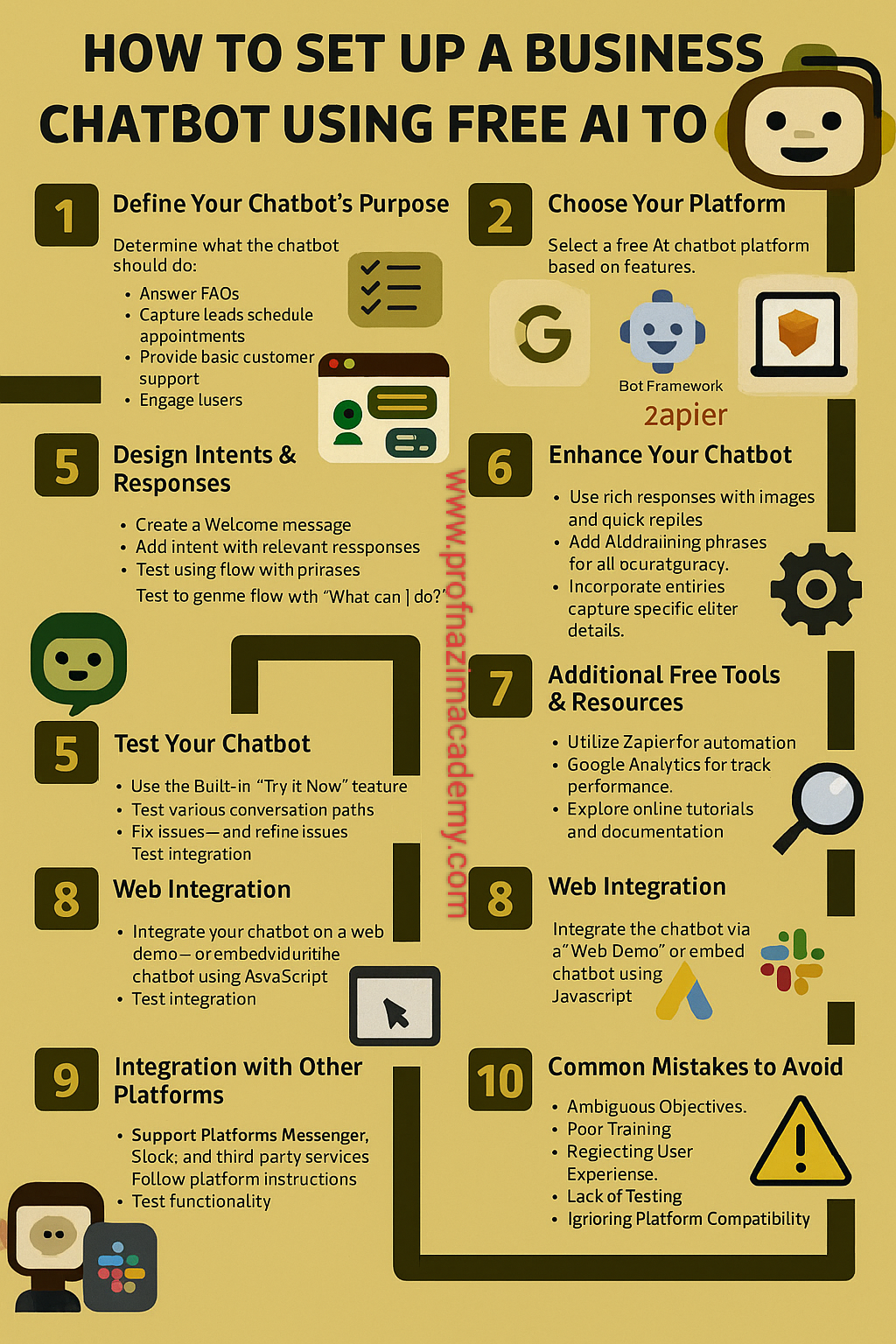How to Set Up a Business Chatbot Using Free AI Tools: A Complete Guide

How to Set Up a Business Chatbot Using Free AI Tools: A Complete Guide
In today’s fast-paced digital world, businesses must adopt efficient communication tools to stay ahead. One such transformative tool is the AI-powered chatbot. Whether you're a startup, small business owner, or enterprise, setting up a business chatbot using free AI tools can greatly enhance your customer interaction and operational efficiency.
In this blog post, we’ll walk you through a simplified, visually-driven guide—based on the updated infographic we created—to help you launch your own business chatbot without spending a dime.
1. Define Your Chatbot’s Purpose
Your first task is strategic: determine why you're building a chatbot. Clearly define your chatbot’s purpose:
- Answer FAQs
- Schedule appointments or capture leads
- Offer customer support
- Entertain or engage users
A well-defined objective ensures clarity and usability from the start.
2. Choose the Right Platform
There are several free AI platforms available, but selecting the one that aligns with your needs is essential. Some popular options include:
Google Dialogflow – Great for natural language understanding.
Bot Framework – Robust tool for advanced users.
2apier (Zapier) – Ideal for integrating workflows with other applications.
Select based on your technical comfort, business scale, and integration needs.
3. Design Intents & Responses
A chatbot’s strength lies in its ability to understand user queries and respond appropriately.
- Create a friendly welcome message.
- Define user intents (e.g., “Book an Appointment”).
- Write specific responses for each intent.
Test with phrases like “What can you do?”
4. Set Up and Develop Your Bot
Most platforms offer visual or low-code development environments. For instance, Dialogflow lets you:
- Create agents
- Set up entities and intents
- Integrate responses and fulfillment
Ensure your bot is aligned with the conversational flow of your users.
5. Test Thoroughly
Before going live:
- Use built-in testing tools like “Try It Now”
- Simulate various user queries
- Fix bugs and refine pathways
Quality testing ensures your chatbot doesn’t frustrate users with incorrect or irrelevant responses.
6. Enhance with Advanced Features
Make your chatbot smarter and more useful:
- Add buttons, carousels, and rich content
- Integrate with external services (CRMs, databases)
- Use entities to capture names, dates, and more
- The richer the interaction, the better the user experience.
7. Leverage Free Tools & Resources
Take advantage of other no-cost tools to expand your chatbot's capabilities:
-Landbot.io – Drag-and-drop chatbot builder
Tidio – Blends live chat with AI
Google Analytics – For performance tracking
These tools help you build, refine, and measure success.
8. Integrate with Your Website
Add your chatbot to your business website using simple HTML or JavaScript:
- Use “Web Demo” options
- Embed codes generated by your chatbot platform
- Test integration on both desktop and mobile
- This ensures 24/7 engagement with your site visitors.
9. Multi-Platform Integration
Deploy your chatbot across channels:
- Facebook Messenger
-Slack
-Third-party tools
Each platform may have different instructions, so follow integration guidelines closely.
10. Avoid Common Mistakes
To ensure your chatbot performs optimally:
- Avoid ambiguous objectives
- Train it with quality data
- Don’t ignore user experience
-Test regularly
Ensure compatibility across platforms
These missteps can sabotage even the most well-built bots.
Finally, creating a business chatbot no longer requires large budgets or advanced coding skills. With free AI tools and the right strategic approach, you can automate interactions, capture leads, and delight customers.
Take this guide as your blueprint. Begin experimenting, learning, and deploying. The future of business communication is conversational—and it’s yours to shape.
Have questions or want a tailored chatbot strategy for your business? Visit us at www.profnazimacademy.com
#AIChatbot #BusinessAutomation #NoCodeTools #FreeAITools #ProfNazimAcademy


Comments ()